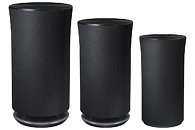Thursday, October 1st 2015

Samsung Expands Radiant360 Speaker Series
Samsung Electronics America, Inc. today unveiled three additions to its Wireless Audio Radiant360 speaker series - the R5, R3 and R1 models. The new speakers feature a breakthrough design that transforms the home entertainment experience with omnidirectional, balanced sound, regardless of speaker or listener position, and even more intuitive controls, new user interface and multiroom capability for greater convenience.
Developed in Samsung's new state-of-the-art U.S.-based Audio Lab, the R5, R3 and R1 join the R7 in the Wireless Radiant360 speaker series line launched earlier this year. Each utilizes Samsung's "Ring Radiator" technology to deliver a vibrant and rich audio experience with balanced room-filling sound, more so than any conventional speaker."The way people listen to music has changed to a more social and shared experience. Consumers no longer sit in between a pair of stereo speakers to enjoy their music, but prefer the music move with them wherever they go," said Jim Kiczek, Vice President of Samsung Electronics America Audio Group. "Our new Radiant360 speakers can be placed anywhere in a room to bring the sweet spot wherever listeners are as they are moving about the home."
The all-black, unique cylinder-shaped design integrates seamlessly into any home décor. With a simple tap, swipe or touch on the top of the speaker, consumers can change the volume, play, pause, advance, or repeat tracks.
The R5, R3 and R1 models connect to the updated Samsung Multiroom App 2.0 for Android and iOS smartphones and tablets, making it possible to seamlessly share music across Wi-Fi connected devices throughout the home. The app also allows users to easily find and select music, and create playlists all from a single screen.
Consumers can also easily connect the Wireless Radiant360 speakers to compatible Samsung TVs and soundbars quickly and easily. Adding a pair of R1 speakers as the "rear" speaker for example, can turn your soundbar into a full surround system.
The R1, R3 and R5 models will be available beginning in mid-October for $199, $299 and $399, respectively, making them a great holiday gift.
Developed in Samsung's new state-of-the-art U.S.-based Audio Lab, the R5, R3 and R1 join the R7 in the Wireless Radiant360 speaker series line launched earlier this year. Each utilizes Samsung's "Ring Radiator" technology to deliver a vibrant and rich audio experience with balanced room-filling sound, more so than any conventional speaker."The way people listen to music has changed to a more social and shared experience. Consumers no longer sit in between a pair of stereo speakers to enjoy their music, but prefer the music move with them wherever they go," said Jim Kiczek, Vice President of Samsung Electronics America Audio Group. "Our new Radiant360 speakers can be placed anywhere in a room to bring the sweet spot wherever listeners are as they are moving about the home."
The all-black, unique cylinder-shaped design integrates seamlessly into any home décor. With a simple tap, swipe or touch on the top of the speaker, consumers can change the volume, play, pause, advance, or repeat tracks.
The R5, R3 and R1 models connect to the updated Samsung Multiroom App 2.0 for Android and iOS smartphones and tablets, making it possible to seamlessly share music across Wi-Fi connected devices throughout the home. The app also allows users to easily find and select music, and create playlists all from a single screen.
Consumers can also easily connect the Wireless Radiant360 speakers to compatible Samsung TVs and soundbars quickly and easily. Adding a pair of R1 speakers as the "rear" speaker for example, can turn your soundbar into a full surround system.
The R1, R3 and R5 models will be available beginning in mid-October for $199, $299 and $399, respectively, making them a great holiday gift.

5 Comments on Samsung Expands Radiant360 Speaker Series
Companies have designed "omni-directional" speakers before. They've had varying success. The biggest problem is the environment or room that the speakers are in. there is no way to account for the room acoustics and the wider the radiation pattern of the sound the more it interacts with the room. Another issue is recordings are not optimized for omni-directional speakers.
Overall the most "accurate" speakers tend to be ones with very narrow dispersion with the listener planted directly in "the sweet spot" on axis and equal distant from the speakers. Large "planer" type speakers like electrostatics, for example, have very narrow radiation patterns and can be set up to be very accurate over a large frequency range. Provided you have a large enough room to get them away from the wall behind the speakers.